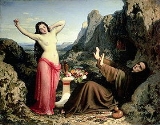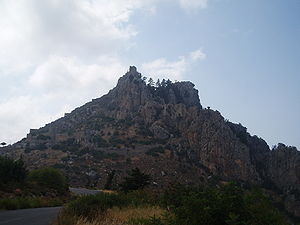
Hilarion
Encyclopedia
Hilarion was an anchorite
who spent most of his life in the desert according to the example of Anthony the Great
.
of pagan parents. He successfully studied rhetoric with a Grammarian in Alexandria. It seems that he was converted to Christianity in Alexandria. After that, he shunned the pleasures of his day—theatre, circus and arena—and spent his time attending church. According to St. Jerome, he was a thin and delicate youth of fragile health.
" (according to St. Jerome), Hilarion, at the age of fifteen, went to live with him in the desert for two months. As Anthony's hermitage was busy with visitors seeking cures for diseases or demonic affliction, Hilarion returned home along with some monks. At Thabatha, his parents having died in the meantime, he gave his inheritance to his brothers and the poor and left for the wilderness.
After he was beset by carnal thoughts, he reduced his diet to the juice of herbs and less figs and took to praying, singing, the hoeing of the soil and the production of baskets made from rushes. Although he was quite starved, "so wasted that his bones scarcely held together" (Jerome) he still frequently heard voices, of infants or of domestic animals, which he identified as demons, and had visions of naked women, voluptuous meals, chariots and gladiatorial contests:
He finally built a hut of reeds and sedges in which he lived for four years. Afterwards, he constructed a tiny low-ceilinged cell, "a tomb rather than a house", where he slept on a bed of rushes, and recited the Bible or sang hymns.
He never washed his clothes, changed them only when they fell apart and shaved his hair only once a year. He was once visited by robbers, but they left him alone when they learned that he did not fear death (and had nothing worth stealing, anyway), promising to mend their ways.
Saint Jerome gives a detailed account of his diet:
After that, he suffered from signs of malnutrition, his eyesight grew poor, his body shrivelled and he developed dry mange and scabs, so he had to slightly modify his diet.
After he had lived in the wilderness for 22 years, he became quite famous in Syria Palaestina. Visitors started to come, begging for his help.
 His first miracle was when he cured a woman from Eleutheropolis
His first miracle was when he cured a woman from Eleutheropolis
(a Roman city in Syria Palaestina) who had been barren for 15 years. Later, he cured blindness, cured three children of a fatal illness, healed a paralysed charioteer, and expelled demons. He even cured horses affected by evil magic and tamed a mad Bactrian Camel.
After numerous adventures, always beset by enthusiastic visitors seeking his help, Hilarion died in Cyprus
in 371 AD.
St. Hilarion Castle in Turkish: "101 houses", see the article Templos
adapted a biography of St. Hilarion as one of the three Lives of Joseph Knecht, making up his Nobel Prize winning novel The Glass Bead Game
(also known as Magister Ludi).
Anchorite
Anchorite denotes someone who, for religious reasons, withdraws from secular society so as to be able to lead an intensely prayer-oriented, ascetic, and—circumstances permitting—Eucharist-focused life...
who spent most of his life in the desert according to the example of Anthony the Great
Anthony the Great
Anthony the Great or Antony the Great , , also known as Saint Anthony, Anthony the Abbot, Anthony of Egypt, Anthony of the Desert, Anthony the Anchorite, Abba Antonius , and Father of All Monks, was a Christian saint from Egypt, a prominent leader among the Desert Fathers...
.
Early life
Hilarion was born in Thabatha, south of Gaza in Syria PalaestinaSyria Palaestina
Syria Palæstina was a Roman province between 135CE and 390CE. It had been established by the merge of Roman Syria and Roman Judaea, following the defeat of the Bar Kokhba Revolt in 135 CE. In 193 Syria-Coele was split to form a separate provincial locality...
of pagan parents. He successfully studied rhetoric with a Grammarian in Alexandria. It seems that he was converted to Christianity in Alexandria. After that, he shunned the pleasures of his day—theatre, circus and arena—and spent his time attending church. According to St. Jerome, he was a thin and delicate youth of fragile health.
Beginnings of monastic Life
After hearing of Saint Anthony, whose name "was in the mouth of all the races of EgyptEgypt
Egypt , officially the Arab Republic of Egypt, Arabic: , is a country mainly in North Africa, with the Sinai Peninsula forming a land bridge in Southwest Asia. Egypt is thus a transcontinental country, and a major power in Africa, the Mediterranean Basin, the Middle East and the Muslim world...
" (according to St. Jerome), Hilarion, at the age of fifteen, went to live with him in the desert for two months. As Anthony's hermitage was busy with visitors seeking cures for diseases or demonic affliction, Hilarion returned home along with some monks. At Thabatha, his parents having died in the meantime, he gave his inheritance to his brothers and the poor and left for the wilderness.
Time at Majoma
Hilarion went to the area southwest of Majoma, the port of Gaza, that was limited by the sea at one side and marshland on the other. It was the abode of robbers. With him he took only a shirt of coarse linen, a cloak of skins given to him by St. Anthony, and a coarse blanket. He led a nomadic life, subsisting only on dried figs, which he ate after sunset.After he was beset by carnal thoughts, he reduced his diet to the juice of herbs and less figs and took to praying, singing, the hoeing of the soil and the production of baskets made from rushes. Although he was quite starved, "so wasted that his bones scarcely held together" (Jerome) he still frequently heard voices, of infants or of domestic animals, which he identified as demons, and had visions of naked women, voluptuous meals, chariots and gladiatorial contests:
He finally built a hut of reeds and sedges in which he lived for four years. Afterwards, he constructed a tiny low-ceilinged cell, "a tomb rather than a house", where he slept on a bed of rushes, and recited the Bible or sang hymns.
He never washed his clothes, changed them only when they fell apart and shaved his hair only once a year. He was once visited by robbers, but they left him alone when they learned that he did not fear death (and had nothing worth stealing, anyway), promising to mend their ways.
Saint Jerome gives a detailed account of his diet:
- from 20-23: half a pint of lentils moistened with cold water
- 23-27: dry bread with salt and water
- 27-30: wild herbs and roots
- 31-35: six ounces of barley bread, and boiled vegetables without oil
After that, he suffered from signs of malnutrition, his eyesight grew poor, his body shrivelled and he developed dry mange and scabs, so he had to slightly modify his diet.
- 35-63: six ounces of barley bread, and boiled vegetables with oil
- 63-80: six ounces of water, boiled vegetables with oil and a broth made from flour and crushed herbs, taken after sunset
After he had lived in the wilderness for 22 years, he became quite famous in Syria Palaestina. Visitors started to come, begging for his help.
Miracles

Eleutheropolis
Eleutheropolis was the Greek name of a Roman city in Israel, some 53 km southwest of Jerusalem. Its remains still straddle the ancient road to Gaza. The site— already rendered as Baitogabra in Ptolemy's Geography— was called Beit Guvrin and Bet Gubrin in the Talmud...
(a Roman city in Syria Palaestina) who had been barren for 15 years. Later, he cured blindness, cured three children of a fatal illness, healed a paralysed charioteer, and expelled demons. He even cured horses affected by evil magic and tamed a mad Bactrian Camel.
Monastery
In time, a monastery grew around his cell, which was so beset by visitors, especially females, that Hilarion fled.After numerous adventures, always beset by enthusiastic visitors seeking his help, Hilarion died in Cyprus
Cyprus
Cyprus , officially the Republic of Cyprus , is a Eurasian island country, member of the European Union, in the Eastern Mediterranean, east of Greece, south of Turkey, west of Syria and north of Egypt. It is the third largest island in the Mediterranean Sea.The earliest known human activity on the...
in 371 AD.
Sources
- In 390 AD at BethlehemBethlehemBethlehem is a Palestinian city in the central West Bank of the Jordan River, near Israel and approximately south of Jerusalem, with a population of about 30,000 people. It is the capital of the Bethlehem Governorate of the Palestinian National Authority and a hub of Palestinian culture and tourism...
, Jerome wrote of Hilarion's life. According to Jerome, Bishop EpiphaniusEpiphanius of SalamisEpiphanius of Salamis was bishop of Salamis at the end of the 4th century. He is considered a saint and a Church Father by both the Eastern Orthodox and Catholic Churches. He gained a reputation as a strong defender of orthodoxy...
of SalamisSalamis, CyprusSalamis was an ancient Greek city-state on the east coast of Cyprus, at the mouth of the river Pedieos, 6 km north of modern Famagusta. According to tradition the founder of Salamis was Teucer, son of Telamon, who could not return home after the Trojan war because he had failed to avenge his...
, had already described his virtues in a well-known letter, which has not been preserved. - See also St. hilarion-Aziz Hilarion in Templos- legends of Cyprus
St. Hilarion Castle in Turkish: "101 houses", see the article Templos
Novelization
Hermann HesseHermann Hesse
Hermann Hesse was a German-Swiss poet, novelist, and painter. In 1946, he received the Nobel Prize in Literature...
adapted a biography of St. Hilarion as one of the three Lives of Joseph Knecht, making up his Nobel Prize winning novel The Glass Bead Game
The Glass Bead Game
The Glass Bead Game is the last full-length novel and magnum opus of the German author Hermann Hesse. Begun in 1931 and published in Switzerland in 1943, after being rejected for publication in Germany, the book was mentioned in Hesse's citation for the 1946 Nobel Prize for Literature."Glass Bead...
(also known as Magister Ludi).

